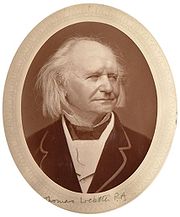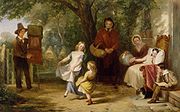
Thomas Webster (painter)
Encyclopedia

England
England is a country that is part of the United Kingdom. It shares land borders with Scotland to the north and Wales to the west; the Irish Sea is to the north west, the Celtic Sea to the south west, with the North Sea to the east and the English Channel to the south separating it from continental...
genre painter, who lived for many years at the artists' colony in Cranbrook
Cranbrook Colony
The Cranbrook Colony was a group of artists who settled in Cranbrook, Kent from 1854 onwards and were inspired by seventeenth century Dutch and Flemish painters...
.
Life
Webster was born in Ranelagh Street, PimlicoPimlico
Pimlico is a small area of central London in the City of Westminster. Like Belgravia, to which it was built as a southern extension, Pimlico is known for its grand garden squares and impressive Regency architecture....
, London. His father was a member of the household of George III
George III of the United Kingdom
George III was King of Great Britain and King of Ireland from 25 October 1760 until the union of these two countries on 1 January 1801, after which he was King of the United Kingdom of Great Britain and Ireland until his death...
, and the son, having shown an aptitude for music, became a chorister, first at St George's Chapel
St. George's Chapel, Windsor Castle
St George's Chapel is the place of worship at Windsor Castle in England, United Kingdom. It is both a royal peculiar and the chapel of the Order of the Garter...
in Windsor Castle
Windsor Castle
Windsor Castle is a medieval castle and royal residence in Windsor in the English county of Berkshire, notable for its long association with the British royal family and its architecture. The original castle was built after the Norman invasion by William the Conqueror. Since the time of Henry I it...
, then the Chapel Royal
Chapel Royal
A Chapel Royal is a body of priests and singers who serve the spiritual needs of their sovereign wherever they are called upon to do so.-Austria:...
at St. James's Palace
St. James's Palace
St. James's Palace is one of London's oldest palaces. It is situated in Pall Mall, just north of St. James's Park. Although no sovereign has resided there for almost two centuries, it has remained the official residence of the Sovereign and the most senior royal palace in the UK...
in London. He abandoned music for painting, however, and in 1821 was admitted as a student to the Royal Academy
Royal Academy
The Royal Academy of Arts is an art institution based in Burlington House on Piccadilly, London. The Royal Academy of Arts has a unique position in being an independent, privately funded institution led by eminent artists and architects whose purpose is to promote the creation, enjoyment and...
, exhibiting, in 1824, portraits of "Mrs Robinson and Family." In the following year he won first prize in the school of painting.

British Institution
The British Institution was a private 19th-century society in London formed to exhibit the works of living and dead artists; it was also known as the Pall Mall Picture Galleries or the British Gallery...
. These were followed by numerous other pictures of school and village life at both galleries. In 1840 Webster was elected an associate of the Royal Academy (ARA), and in 1846 a Royal Academician (RA) academician. He continued to be a frequent exhibitor till 1876, when he retired from the academy. He exhibited his own portrait in 1878, and 'Released from School,' his last picture, in 1879.
In 1856 Webster was photographed at 'The Photographic Institute', London, by Robert Howlett
Robert Howlett
Robert Howlett , was a pioneering British photographer whose pictures are widely exhibited in major galleries. Howlett produced portraits of Crimean War heroes, genre scenes and landscapes...
, as part of a series of portraits of 'fine artists'. The picture was among a group exhibited at the Art Treasures Exhibition in Manchester
Manchester
Manchester is a city and metropolitan borough in Greater Manchester, England. According to the Office for National Statistics, the 2010 mid-year population estimate for Manchester was 498,800. Manchester lies within one of the UK's largest metropolitan areas, the metropolitan county of Greater...
in 1857.
From 1835 to 1856 Webster resided at The Mall, Kensington
Kensington
Kensington is a district of west and central London, England within the Royal Borough of Kensington and Chelsea. An affluent and densely-populated area, its commercial heart is Kensington High Street, and it contains the well-known museum district of South Kensington.To the north, Kensington is...
, but the last thirty years of his life were spent at the artists' colony in Cranbrook
Cranbrook Colony
The Cranbrook Colony was a group of artists who settled in Cranbrook, Kent from 1854 onwards and were inspired by seventeenth century Dutch and Flemish painters...
, Kent, where he died on 23 Sept. 1886.
Work

In the limited range of subjects which he made his own, Webster was unrivalled. Some of his pictures - such as 'Please remember the Grotto', 'Snowballing' and maybe 'The Swing' - were produced as prints by Abraham Le Blond. 'The Smile' (1841), 'The Frown' and 'The Boy with Many Friends', are among the numerous pictures which became well known by engravings.
Other paintings include: The Truant (1836), 'In Sickness and Health' (1843), The artist's father and mother (first exhibited at the Royal Academy in 1844), A Dame's School (1845) and 'The Village Choir' (1847). Webster also contributed work to volumes issued by the London-based Etching Club
The Etching Club
The Etching Club was an artists' society founded in London, England in 1838 by Charles West Cope. The club published illustrated editions of works by authors such as Oliver Goldsmith, Shakespeare, John Milton and Thomas Gray...
: 'The Deserted Village' (1841), 'Songs of Shakespeare' (1843), and 'Etch'd Thoughts' (1844).
Webster was influential on the work of fellow Cranbrook artists George Bernard O'Neill
George Bernard O'Neill
George Bernard O'Neill , was a prolific Anglo-Irish genre painter, from 1859 a member of the Cranbrook Colony of artists.-Life and work:...
and Frederick Daniel Hardy
Frederick Daniel Hardy
Frederick Daniel Hardy was an English genre painter and member of the Cranbrook Colony.-Life:Hardy was born in Windsor in Berkshire, one of six children of George Hardy , a musician to George IV, Queen Adelaide and Queen Victoria in the Royal household at Windsor...
.
External links
- Thomas Webster online (ArtCyclopedia)
- Thomas Webster biography and works (Royal AcademyRoyal AcademyThe Royal Academy of Arts is an art institution based in Burlington House on Piccadilly, London. The Royal Academy of Arts has a unique position in being an independent, privately funded institution led by eminent artists and architects whose purpose is to promote the creation, enjoyment and...
collection) - Thomas Webster biography and art (The Weald - people history and genealogy)
- The Dunce (c. 1850 painting)
- Thomas Webster biography ("Find A Grave)

